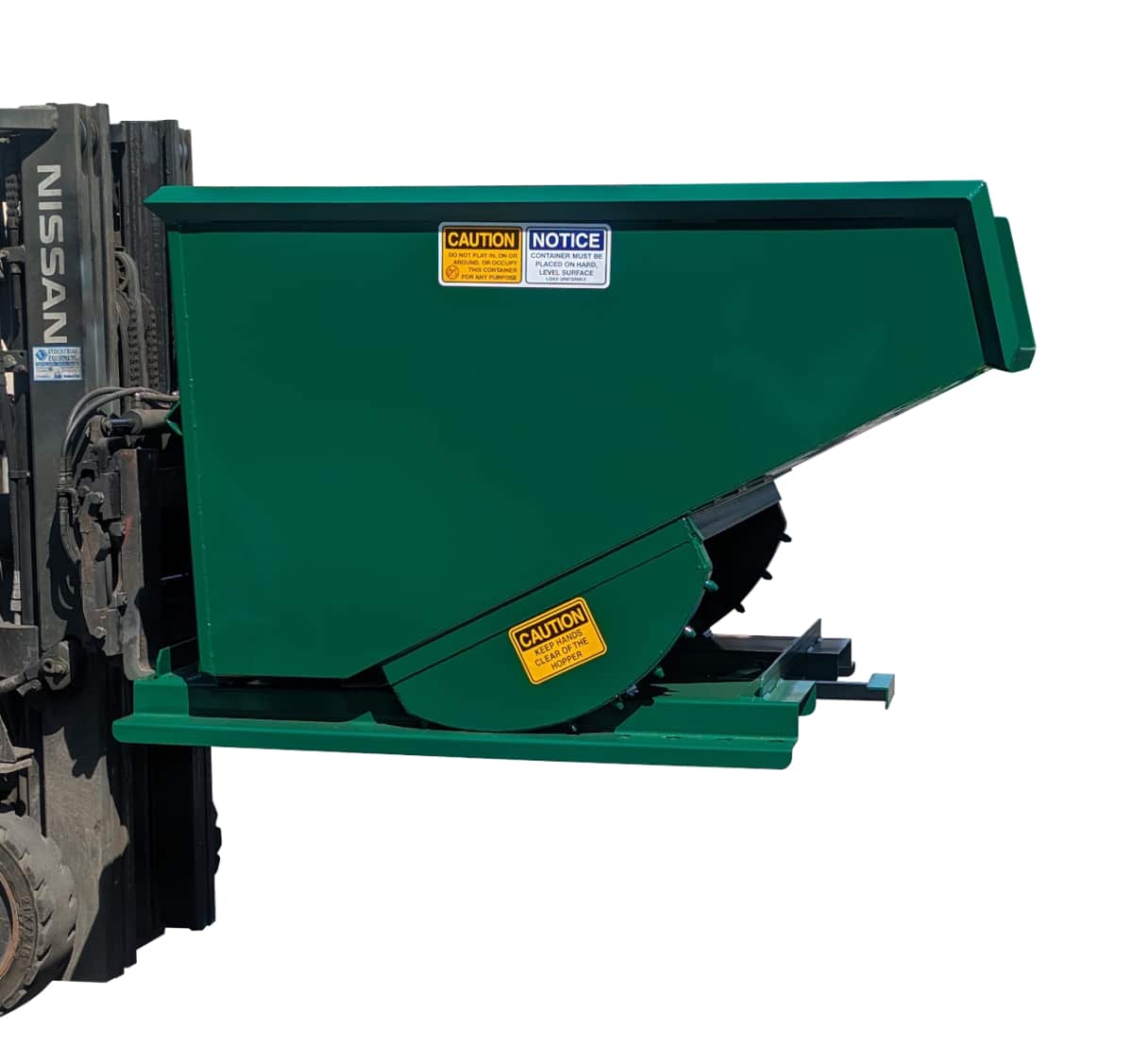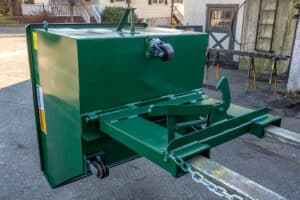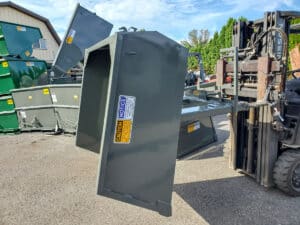Key Takeaways
- Self-dumping hoppers are smaller trash hopper most often used indoors next to workstations (like in manufacturing facilities). They can be lifted with a forklift, and quickly whisked outdoors where the contents (metal scraps, wood, etc.) can be dumped into a larger dumpster…often a roll-off dumpster!
- Roll-off dumpsters are delivered by truck and “roll off” backwards, hence their name. They are usually 5 to 10 times the size of a self-dumping hopper: good for lots of waste, not great for convenience given their height.
- The best use for both? Pair them! A dump hopper can be used to easily put your waste materials into a roll-off dumpster. That can be in manufacturing settings, but also on construction sites.
First, What Exactly Is a Self-Dumping Hopper?
A self dumping hopper is a steel container built for daily use around the shop floor, construction site, or warehouse. You’ll usually find dump hoppers parked right next to workstations, machines, or cutting areas, ready to collect scrap, trash, or materials that pile up quickly. These compact units are then designed to partner up and sit on forklifts, making it fast and simple for workers to lift, tilt forward, dump completely, and automatically return the hopper to its upright position. They are generally 1/4 to 8-cubic yards in size.
They hold up to heavy duty work, day in and day out.

What’s a Roll-Off Dumpster?
A roll-off dumpster is that giant container that gets delivered by truck, then rolled backwards onto the ground. It’s a common sight at demolition projects, construction sites, and anywhere there’s a significant amount of debris to toss. They are often 20 or 40 cubic yards in size.
Roll-off dumpsters are built to handle a large volume of bulk material. When full, they’re picked up and hauled off – ideal for jobs with a mountain of mess that needs to be removed all at once. They’re usually part of long-term waste management for projects that last days or even weeks, or they’re parked outside of manufacturing facilities or woodshops to be emptied weekly or so.
Really, they work together much of the time! Self-dumping hoppers are most frequently used to dump INTO rolloff dumpsters!
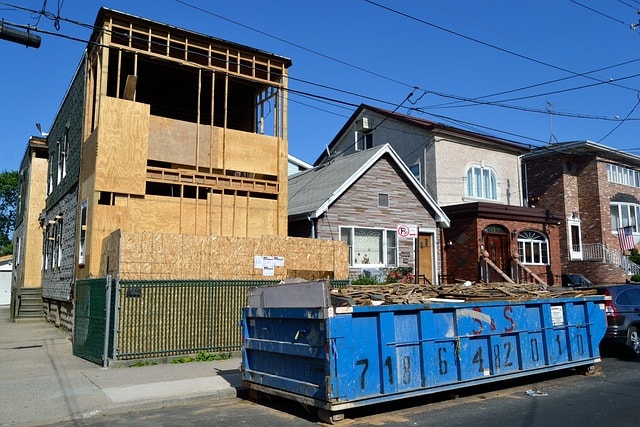
Self-Dumping Hoppers vs. Roll-Off Dumpsters: The Real Differences
Here’s where it gets interesting. Dump hoppers and dumpsters both collect trash and materials, but they operate in completely different ways:
- Mobility: Hoppers stay on-site and move with forklifts. Dumpsters need a truck to arrive, unload, and haul away.
- Use case: Dump hoppers handle repetitive, everyday dumping. Roll-offs handle one-time, big-load disposal.
- Capacity: A standard self dumping hopper usually ranges from 1/4 to 8 cubic yards, while roll-off dumpsters come in massive sizes like 10, 20, 30, or even 40 yards.
- Terminology: You’ll also hear hoppers called trash hoppers or scrap hoppers, depending on what kind of materials they’re handling.
If your team is constantly dealing with scrap metal, broken parts, or packaging waste, having a hopper right at the work zone saves time and cuts the distance between the mess and the container.
Which Option Works Best for Construction Sites?
Roll-off dumpsters often make the most sense for large-scale construction or demolition projects. If you’re tearing off a roof or gutting an interior, that increased capacity really matters.
But if you’re working indoors, in tighter spaces, or managing frequent loads of debris and scrap, self dumping hoppers are the way to go. They boost operational efficiency and reduce time spent hauling trash across the site.
On jobs with both indoor and outdoor work, combining both options gives you flexibility. Hoppers stay close to the action, while roll-offs handle the bigger cleanup at the end.
Or, many construction companies find self-dumping hoppers useful in moving waste from one part of the jobsite to another. In that way, they can be a perfect pairing.
Breaking Down the Cost: Which One Makes More Sense?
Renting a roll-off dumpster can get pricey. There are drop-off fees, pickup charges, rental time windows, and weight restrictions. Go over your weight limit? That’ll cost extra too.
Self dumping hoppers, on the other hand, are usually a one-time purchase. They’re part of your equipment fleet. Over a longer period, especially on active job sites or inside production facilities, they often make more financial sense. You get repeat use without repeat charges.
Can You Use Both at Once?
Definitely, and many of the most organized work zones do. Dump hoppers help with the daily grind: wood scraps, packaging waste, offcuts, and various materials that build up throughout the day.
When it’s time for a big clean-out or the job wraps up, roll-off dumpsters are ready to collect everything that won’t fit in the smaller containers.
Again, the reality is that many businesses use self-dumping hoppers to move waste INTO a rolloff dumpster located outside the building.
It’s a waste disposal strategy that works from every angle.
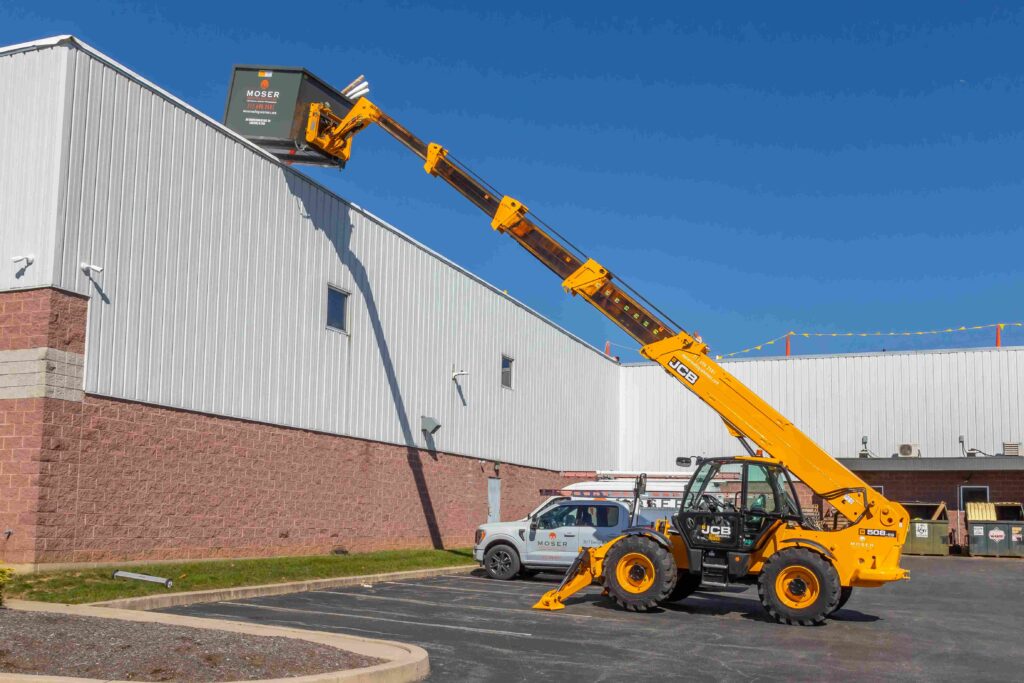
Common Questions About Dump Hoppers and Dumpsters
Can I rent a self dumping hopper like I would a dumpster?
Absolutely! Dump hoppers are often available for rent depending where you are (in Lancaster, give us a call!), and it’s worth talking to your local rental company. They’re equipment that’s meant to stay with you for the long haul.
Are dump hoppers safe to use with forklifts?
Yes. They’re engineered with fork attachments built in, and they’re designed to dump completely and automatically return upright. Just make sure your workers are trained on safe operation.
Which option handles heavy materials better?
If you’re dealing with constant scrap throughout the day, hoppers are your friend. For disposing of heavy loads all at once, roll-offs might be the better choice though, especially for large containers of roofing debris, drywall, or old framing. Or, you might use a dump hopper to load the roll-off dumpster.
Key Advantages of Self Dumping Hoppers
- They’re placed where the work happens and sometimes built custom to fit beneath worktables or manufacturing equipment, reducing time spent walking back and forth with buckets or wheelbarrows. Roll-offs can’t be placed indoors, typically.
- Built with heavy duty, robust construction to handle abuse from sharp scrap, dense materials, and general job site mess.
- Allow workers to dump materials quickly, without getting off the forklift.
Quick Note on Trash Hopper vs Scrap Hopper
- A trash hopper or tilt dumpster is for lighter materials: cardboard, packaging, office trash, and similar waste
- A scrap hopper is usually reinforced to carry heavy materials like steel offcuts, bolts, or concrete chunks
- Both are part of the same extensive line of self dumping hoppers. Just match the right type to your specific needs
Final Thoughts: Which One’s Right for You?
If your team deals with scrap, debris, or materials that need to be cleared out constantly throughout the day, a self dumping hopper will absolutely save time and boost efficiency.
If your project calls for major demolition, remodeling, or bulk clean-out work, you might need the increased capacity that a roll-off dumpster provides.
But in many situations, using both gives you a complete waste management setup: one container close to the action for small, frequent loads—and another for hauling everything else away.
Still trying to make the right choice for your job site or facility? We’d be glad to help. Our extensive line of self dumping hoppers is built to last, engineered for safety, and designed to make your daily operation smoother. Whether you’re handling heavy materials, construction debris, or just trying to save time, our hoppers are up for the task. Give us a call to learn more about buying dump hoppers online today!

